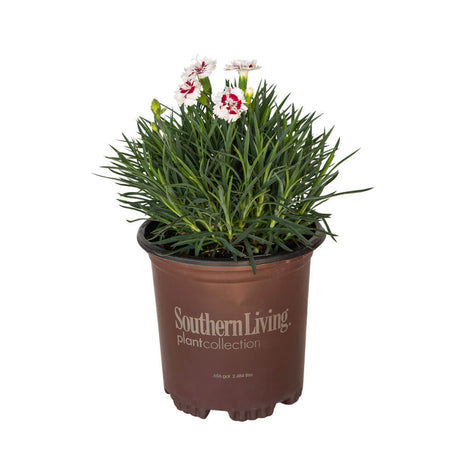FiltersFilter & Sort
- 6% off
Southern Living Plant Collection
ScentFirst Coconut Surprise Dianthus
$16.99$17.99Unit price /UnavailableIn stock (188) - 6% off
Southern Living Plant Collection
American Pie Georgia Peach Dianthus
$16.99$17.99Unit price /UnavailableIn stock (160) - 6% off
Southern Living Plant Collection
Scent First Raspberry Surprise Dianthus
$16.99$17.99Unit price /UnavailableIn stock (69)
Dianthus, commonly known as pinks, is a group of flowering plants that are popular for their attractive and fragrant blooms. Here are some reasons why you should consider adding dianthus to your garden and how to grow them successfully:
Reasons to Have Dianthus in Your Garden
- Attractive Flowers: Dianthus produces delicate and colorful blooms in shades of pink, red, white, and bi-colored varieties. They are also known for their spicy fragrance, which makes them a great addition to any garden or landscape.
- Low Maintenance: Dianthus is a low-maintenance plant that is easy to grow and care for. They require minimal pruning and deadheading, and can tolerate a range of soil and environmental conditions.
- Long-Lasting Blooms: Dianthus plants typically bloom from late spring to early fall, providing a long-lasting source of color and fragrance to your garden.
- Versatile: Dianthus is a versatile plant that can be grown in a range of settings, including garden beds, rock gardens, and containers. They are also great for adding color and fragrance to borders and pathways.
- Soil: Dianthus prefers well-draining soil that is rich in organic matter. If your soil is heavy, add some sand or gravel to improve drainage.
- Sunlight: Dianthus prefers full sun, but can also tolerate partial shade. Make sure to plant it in an area that gets at least six hours of direct sunlight per day.
- Watering: Dianthus is a drought-tolerant plant that prefers to be kept on the drier side. Water only when the top inch of soil is dry, and avoid overwatering to prevent root rot.
- Fertilizer: Dianthus does not require much fertilizer, but can benefit from a balanced, slow-release fertilizer applied once in the spring.
- Pruning: Deadhead dianthus regularly to encourage more blooms throughout the growing season. You can also cut back the foliage in the fall to promote healthy growth in the following year.
- Propagation: Dianthus can be propagated through division in the spring or fall. Simply dig up the plant and separate the roots into individual plants.
- Pests and Diseases: Dianthus is generally pest and disease-resistant, but can be susceptible to root rot if overwatered. Keep the foliage dry and provide good air circulation to prevent this disease.


















